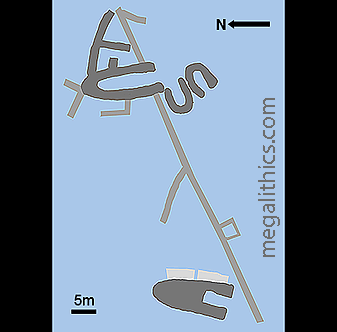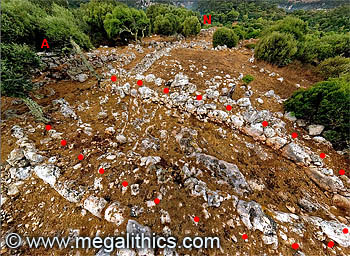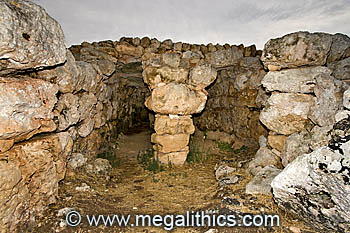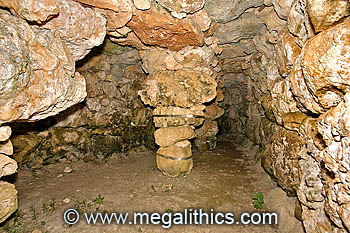

 |
 |
|
More Photos |
||
|
|
VR Tour |
||||
|
|
3D Vision |
||||
|
|
|||||
|
|
| 39.95451 N 4.00611 E (GPS 16min) | |
| Visited Sept 2009 | Altitude 95m OD (Naveta roof) |
The settlement of Mercer de Baix lies about 3km south of the large town of Ferreries situated at an altitude of 95m on the NW cliff of a deep ravine known as Barranc de sa Cova. The site is fairly remote and is reached by dirt road and finally by what can only be called a track. The settlement now consists of the excavated remains of at least three navetiform buildings and a naveta, with later walling structures superimposed.
Our coverage of this site is not as complete as usual, a violent electrical storm began whilst we were on site and we thought that continuing to use metal tripods and monopods on one of the highest points in the local landscape under such conditions might not be a good idea.
The Bronze Age in Menorca began around 2000-1750BC and this marked a great change in social organisation and dwelling structures. In the earlier Chalcolithic age the typical domestic dwellings were small round houses, but around 1700-1650BC these were replaced by elaborate buildings with a horseshoe-shaped plan, the navetiform. In some cases, the replacement was quite literal, the navetiforms being built directly upon the remains of earlier round houses.
The term navetiform is derived from "Naveta" this was a name first used by Ramis (1) in 1818 to describe the Els Tudons monument, at the time this was the only monument of the type known, and he thought that the the long shape with its in-curving sides looked very much like the hull of an up-turned boat, hence "naveta" (little boat). The first navetas that were discovered were funerary monuments, but as Balearic archaeological investigation progressed the remains of horseshoe shaped buildings were found that had obviously been used as domestic dwellings. These dwellings became known as navetiforms (or sometimes naviforms), the obvious similarity of the two structures causes much confusion even today, particularly in the case of ruinous examples.
 Mercer de Baix is typical of navetiform
settlement in a higher ground setting, this would have been a small farm
populated by an extended family that would exploit and manage all of the local
resources in their area. Settlements of this type have two, three, and sometimes
four navetiform buildings, often surrounded by a rectangular stone corral wall.
The navetiforms are constructed of cyclopean masonry, the walls consist of two
facings of large blocks filled with gravel and smaller stones. In a small
settlement the navetiforms are usually clustered together and often, when two navetiforms adjoin each other, they share a common wall.
Conjoined assemblies of three and four navetiforms are also known. The walls of
the buildings corbel in gradually to
reduce the gap to be spanned by roofing, this usually seems to have consisted of logs
covered with gravel and then sealed against rainwater with clay. Hardened clay and
traces of timber have often been found in the in-fallen strata inside ruined navetiforms.
Mercer de Baix is typical of navetiform
settlement in a higher ground setting, this would have been a small farm
populated by an extended family that would exploit and manage all of the local
resources in their area. Settlements of this type have two, three, and sometimes
four navetiform buildings, often surrounded by a rectangular stone corral wall.
The navetiforms are constructed of cyclopean masonry, the walls consist of two
facings of large blocks filled with gravel and smaller stones. In a small
settlement the navetiforms are usually clustered together and often, when two navetiforms adjoin each other, they share a common wall.
Conjoined assemblies of three and four navetiforms are also known. The walls of
the buildings corbel in gradually to
reduce the gap to be spanned by roofing, this usually seems to have consisted of logs
covered with gravel and then sealed against rainwater with clay. Hardened clay and
traces of timber have often been found in the in-fallen strata inside ruined navetiforms.
The three navetiforms clustered at the eastern end of the Mercer de Baix settlement have been extensively ruined, in the case of the single large building, only one or two courses of the walls remain. The two smaller adjoined navetiforms are in a better state, but as the site has been excavated it is unclear how much of this is due to restoration, the walls of the NE navetiform, in particular, are higher than any of the others. Strangely, unlike many other examples, the two closely adjoining navetiforms do not share a common wall, there being a clear space between them, again the degree of reconstruction here is unknown. Apart from the navetiforms, there is a confusing jumble of old walls in a roughly triangular area to the extreme east of the site, constructions stop there only a few metres from sheer cliff fall off into the ravine.
 The large structure to the extreme west of the site is often
named "Cova des Moro" or "Cova del Moor" (alluding to Moorish influences) and
the building is
widely referred to as being a Naveta, indeed, Mascaro
(2) included it in his
list of the ten most outstanding Menorcan navetas in 1968.
The large structure to the extreme west of the site is often
named "Cova des Moro" or "Cova del Moor" (alluding to Moorish influences) and
the building is
widely referred to as being a Naveta, indeed, Mascaro
(2) included it in his
list of the ten most outstanding Menorcan navetas in 1968.
The building measures about 21.8m by 9.5m externally, as the exact nature of the original roofing is unknown the external height is uncertain, but internally, the roofing slabs are around 2.5m above the column footings. Amazingly, part of the building is still roofed, as the structure has obviously been restored to some extent we are unsure how much of the building is original and will describe it as it existed during our visit. The outer skin of the walls is comprised of very well fitted large stone blocks, the faces of which appear to have been dressed to a high standard of smoothness. By comparison, the inner skin of the walls is made up of smaller blocks which are much rougher and appear to be undressed. At least two smaller structures seem to have been built against the eastern flank of the naveta and the remains of their rough walls now lie exposed. In the floor of the northernmost is a curious square "tank" structure, the slabs it is made from resemble the well-dressed stone of the naveta's outer skin. The southern end of the naveta was the original entrance and this section is so heavily damaged that we could not tell where the original facade had been located. The original plan of the facade must have been evident on excavation however, as Pericot (3) claims that it was curved, a feature shared by the Navetas of Els Tudons and Rafal Rubai. The Tudons and Rubai navetas all have upper storeys, and Pericot also claims this feature for the Mercer de Baix naveta, although there is no sign of it today.
 The most striking feature of the structure must be its
columned roof arrangement. Plan diagrams show the original internal space to
have been about 15m long and about 9m of this is roofed today. The roofed
section is supported by three stone columns roughly evenly spaced, these columns
are of the "Mediterranean" type, in other words, the columns are thickest at the
top and taper in towards the base. The roofing slab arrangement has the
column tops being being spanned along the length of the chamber by long slabs,
the gap between this "spine" and the side walls is then covered by two rows of
laterally placed "rib" slabs. This roofing arrangement became very familiar to
us during our Menorcan expeditions, we saw it employed to roof many structures,
such as the internal chambers of Talaiots, well chambers, and the hypostyle
courts found in the houses of Talaiotic settlements. Plan diagrams of the naveta
show footings for a fourth column at the correct spacing in the unroofed area
(although this was not visible during our visit), so the roof must have extended
at least that far originally, presumably the whole interior was once roofed.
The most striking feature of the structure must be its
columned roof arrangement. Plan diagrams show the original internal space to
have been about 15m long and about 9m of this is roofed today. The roofed
section is supported by three stone columns roughly evenly spaced, these columns
are of the "Mediterranean" type, in other words, the columns are thickest at the
top and taper in towards the base. The roofing slab arrangement has the
column tops being being spanned along the length of the chamber by long slabs,
the gap between this "spine" and the side walls is then covered by two rows of
laterally placed "rib" slabs. This roofing arrangement became very familiar to
us during our Menorcan expeditions, we saw it employed to roof many structures,
such as the internal chambers of Talaiots, well chambers, and the hypostyle
courts found in the houses of Talaiotic settlements. Plan diagrams of the naveta
show footings for a fourth column at the correct spacing in the unroofed area
(although this was not visible during our visit), so the roof must have extended
at least that far originally, presumably the whole interior was once roofed.
Although Pericot claims that the roof support columns at Mercer de Baix are unique, similar columns have been found in navetiform buildings in other Balearic settlements, such as those at Can Closos Gaia and Can Sergent. Unfortunately we could not find an excavation report for the Mercer de Baix settlement as we would have been very interested to see if any human remains were discovered in the naveta. It seemed to us that the plan of the naveta was almost identical to the large navetiform at the site and it is was likely that it shared a similar function, i.e. domestic rather than funerary. As the facade of the naveta has been destroyed, any traces of the rebated entrance aperture or upper storey access shaft that would have confirmed a funerary function for the "naveta" have disappeared. There are also no traces of any walling above the present roof level, which would be required for the claimed characteristic upper storey of a funerary naveta.
Recent radiocarbon dates from definite funerary navetas show these structures beginning to be used around 1400BC, but their most intensive period of use was 1050-800BC (4). This finding is very interesting as "open landscape" small navetiform farms and villages were abandoned between 900-800BC as the high density, walled, talaiotic settlements come into full currency. These findings add weight to the idea that the Mercer "naveta" may have indeed been a navetiform with domestic function.
1.
Ramis Y Ramis J., Antiguedades celticas de la Isla de Menorca desde los tiempos
ma's remotos hasta el siglo V de la Era Cristiana, Mahon 1818.
2.
Mascaro Pasarius J., Las Taulas, Mahon, 1968.
3.
Pericot Garcia l., The Balearic Islands, p.78,Thames and
Hudson, 1972.
4.
Guerro V.M., Calvo M. Gornes S., Historia De Las Baleares, Vol 2. Mallorca y
Menorca en la Edad del Hierro, p.207, El Mundo-el Dia de Baleares, 2006.